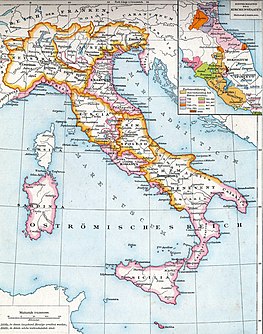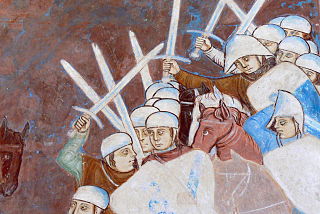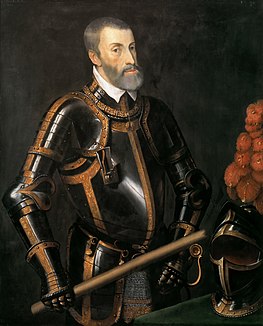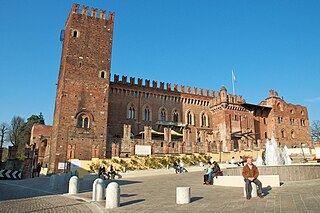History
The castle occupies the ancient site of Comum Oppidum, the original settlement of Como, dating from the 1st millennium BC. Later it was one of the last Byzantine strongholds in the area, surrendering to the Lombards in 588. The castle was restored during the War of the Lombard League, with the help of emperor Frederick Barbarossa (1158). Barbarossa officially donated it to the citizens of Como in 1178.

The Lombards or Longobards were a Germanic people who ruled most of the Italian Peninsula from 568 to 774.
Napoleone della Torre died here in 1278, having been imprisoned here by Ottone Visconti after the Battle of Desio; his nephew Guido was able to escape in 1283, as well as his brothers Corrado and Enrico the following year. Azzone Visconti restored and enlarged the fortification after conquering Como in 1335, and built another castle, the Castello della Torre Rotonda ("Castle of the Round Tower", now lost) and a citadel.
Napoleone della Torre, also known as Napo della Torre or Napo Torriani, was an Italian nobleman, who was effective Lord of Milan in the late 13th century. He was a member of the della Torre family, the father of Corrado della Torre and the brother of Raimondo della Torre.

Ottone Visconti was Archbishop of Milan and Lord of Milan, the first of Visconti line. Under his rule, the commune of Milan became a strong Ghibelline city and one of the Holy Roman Empire's seats in Italy.

The Battle of Desio was fought on 21 January 1277 between the Della Torre and Visconti families for the control of Milan and its countryside. The battlefield was located near the modern Desio, a commune outside the city in Lombardy, Northern Italy.
In 1527, by order of emperor Charles V, the castle was dismantled, with the exception of the tower, to prevent it from falling in hands of the French troops that had invaded the duchy of Milan. After belonging to monks and then to private individuals, the castle was restored in 1971.

Charles V was Holy Roman Emperor (1519-1556), King of Spain and ruler of the Spanish Empire, Archduke of Austria, and ruler of the Habsburg Netherlands (1506-1555). The Spanish conquest of the Aztecs and Incas, and the German colonisation of Venezuela both occurred during his reign. Charles V revitalized the medieval concept of the universal monarchy of Charlemagne and travelled from city to city, with no single fixed capital: overall he spent 28 years in the Habsburg Netherlands, 18 years in Spain and 9 years in Germany. After four decades of incessant warfare with the Kingdom of France, the Ottoman Empire, and the Protestants, Charles V abandoned his multi-national project with a series of abdications between 1554 and 1556 in favor of his son Philip II of Spain and brother Ferdinand I of Austria. The personal union of his European and American territories, spanning over nearly 4 million square kilometres, was the first collection of realms to be defined as "the empire on which the sun never sets".

The Duchy of Milan was a state of the Holy Roman Empire in northern Italy. It was created in 1395, when it included twenty-six towns and the wide rural area of the middle Padan Plain east of the hills of Montferrat. During much of its existence, it was wedged between Savoy to the west, Venice to the east, the Swiss Confederacy to the north, and separated from the Mediterranean by Genoa to the south. The Duchy eventually fell to Habsburg Austria with the Treaty of Baden (1714), concluding the War of the Spanish Succession. The Duchy remained an Austrian possession until 1796, when a French army under Napoleon Bonaparte conquered it, and it ceased to exist a year later as a result of the Treaty of Campo Formio, when Austria ceded it to the new Cisalpine Republic.
Description
The most preserved element is a square tower, measuring 8.20 m × 8.35 m (26.9 ft × 27.4 ft) at the base, and standing at 27.50 m (90.2 ft). It once had Guelph-type merlons. The walls are of Byzantine origin (6th-7th century); these were later heightened and provided with Guelph merlons, while another external line of walls was added.

A merlon is the solid upright section of a battlement in medieval architecture or fortifications. Merlons are sometimes pierced by narrow, vertical embrasures or slits designed for observation and fire. The space between two merlons is called a crenel, and a succession of merlons and crenels is a crenellation. Crenels designed in later eras for use by cannons were also called embrasures.
Also from the 6th century are the Chapel of St. Nicholas and quadrangular tower (4.40 m × 4.15 m (14.4 ft × 13.6 ft) at the base), which was used as the castellan's residence. Napoleone della Torre was buried in the Chapel of St. Nicholas.
A castellan was the governor or captain of a castellany and its castle. The word stems from the Latin Castellanus, derived from castellum "castle". Sometimes also known as a constable, governor of the castle district or captain, the Constable of the Tower of London is, in fact, a form of castellan. A castellan was almost always male, but could occasionally be female, as when, in 1194, Beatrice inherited her father's castellany of Bourbourg upon the death of her brother, Roger.
This page is based on this
Wikipedia article Text is available under the
CC BY-SA 4.0 license; additional terms may apply.
Images, videos and audio are available under their respective licenses.

Vigevano is a town and comune in the province of Pavia, Lombardy in northern Italy. A historic art town, it is also renowned for shoemaking and is one of the main centres of Lomellina, a rice-growing agricultural district. Vigevano received the honorary title of city with a decree of Duke Francis II Sforza on 2 February 1532. It is famed for its beautiful Renaissance "Piazza Ducale" in the centre of the town.

Visconti is the family name of important Italian noble dynasties of the Middle Ages. The Visconti of Milan rose to power in their city, where they ruled from 1277 to 1447, initially as Lords then as Dukes and where several collateral branches still exist.
The effective founder of the Visconti lordship of Milan was Ottone, who wrested control of the city from the rival Della Torre family in 1277.

Arona is a town and comune on Lake Maggiore, in the province of Novara. Its main economic activity is tourism, especially from Milan, France and Germany.

Lonato del Garda is a town and comune in the province of Brescia, in Lombardy, northern Italy. Lonato is located about halfway between Milan and Venice, on the southwest shore of Lake Garda, the biggest lake in Italy.

Monselice is a town and municipality (comune) located in northeastern Italy, in the Veneto region, in the province of Padua.

Sforza Castle is in Milan, northern Italy. It was built in the 15th century by Francesco Sforza, Duke of Milan, on the remnants of a 14th-century fortification. Later renovated and enlarged, in the 16th and 17th centuries it was one of the largest citadels in Europe. Extensively rebuilt by Luca Beltrami in 1891–1905, it now houses several of the city's museums and art collections.

Taurisano is a town and comune in the province of Lecce, in the Apulia region of south-east Italy. It is located in the Salento area. Nearby towns are Acquarica del Capo, Casarano, Ruffano and Ugento.

The Della Torre were an Italian noble family who rose to prominence in Lombardy during the 12th-14th centuries, until they held the lordship of Milan before being ousted by the Visconti.

The Castles of Bellinzona are a group of fortifications located around the town of Bellinzona, the capital of the Swiss canton of Ticino. Situated on the Alpine foothills, the group is composed of fortified walls and three castles named Castelgrande, Montebello and Sasso Corbaro. Castelgrande is located on a rocky peak overlooking the valley, with a series of walls that protect the old city and connect to Montebello. Sasso Corbaro, the highest of the three castles, is located on an isolated rocky promontory south-east of the other two. The Castles of Bellinzona with their defensive walls have been an UNESCO World Heritage Site since 2000.
Guido della Torre was a Lord of Milan between 1302 and 1312.

Visconteo Castle Italian: Castello Visconteo is a castle in Locarno, Switzerland. It is a Swiss heritage site of national significance.

Matteo I Visconti was the son of Teobaldo Visconti and Anastasia Pirovano.

Montechino Castle is located in Montechino village, in the municipality of Gropparello, in the Riglio valley, province of Piacenza, Italy. It is situated on the crest of Monte Occhino hill, overlooking the Riglio river.

The Castello di Carimate is a 14th-century castle located on Piazza Castello #1 in the town of Carimate, Province of Como, Lombardy, Italy.

The Visconti Castle of Crenna is a castle of Middle Age origin located in Crenna, frazione of Gallarate, Lombardy, Northern Italy. It is linked to the fame of Lodrisio Visconti, who raised against and then reconciled with the members of the family of his cousin Matteo Visconti, Lord of Milan. In the 14th century, the castle underwent expansion and destruction according to the alternative fortunes of Lodrisio.























